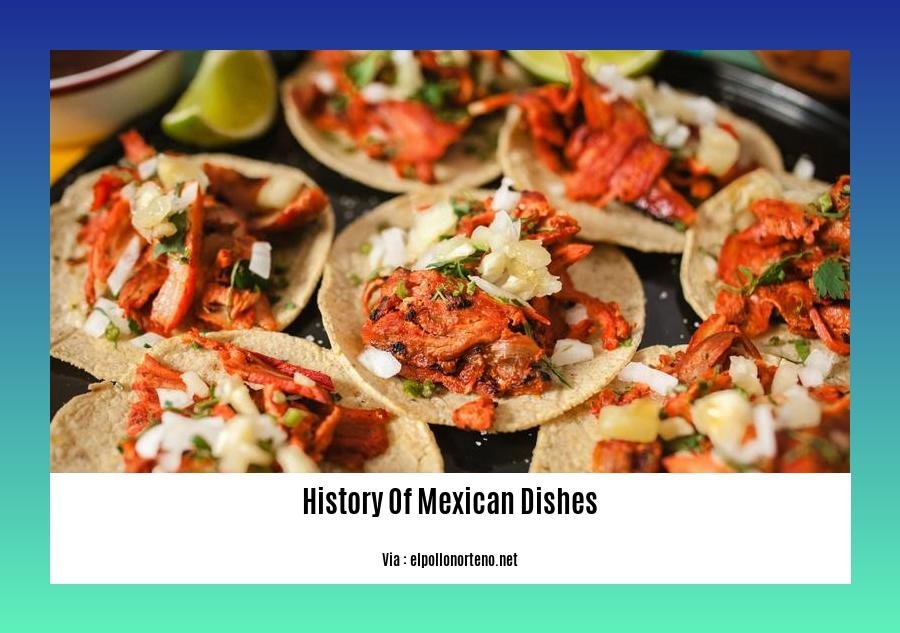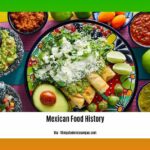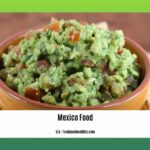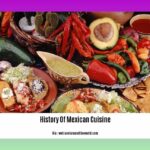Discover the rich history of Mexican cuisine in this culinary journey through time. From the humble origins of tacos to the complex flavors of mole poblano, we’ll explore the stories behind some of Mexico’s most iconic dishes. Join us as we uncover the cultural influences and historical events that have shaped the culinary landscape of this vibrant country.
Key Takeaways:
Mexican cuisine has roots in Mayan, Aztec, and Spanish cultures.
The Mayans consumed foods like corn, beans, squash, and chilies.
The Aztecs incorporated tomatoes, avocados, and chocolate into their diet.
Spanish colonization introduced wheat, rice, dairy, and meat.
Modern Mexican cuisine reflects a fusion of indigenous and Spanish traditions, influenced by regional variations and global culinary trends.
History of Mexican Dishes
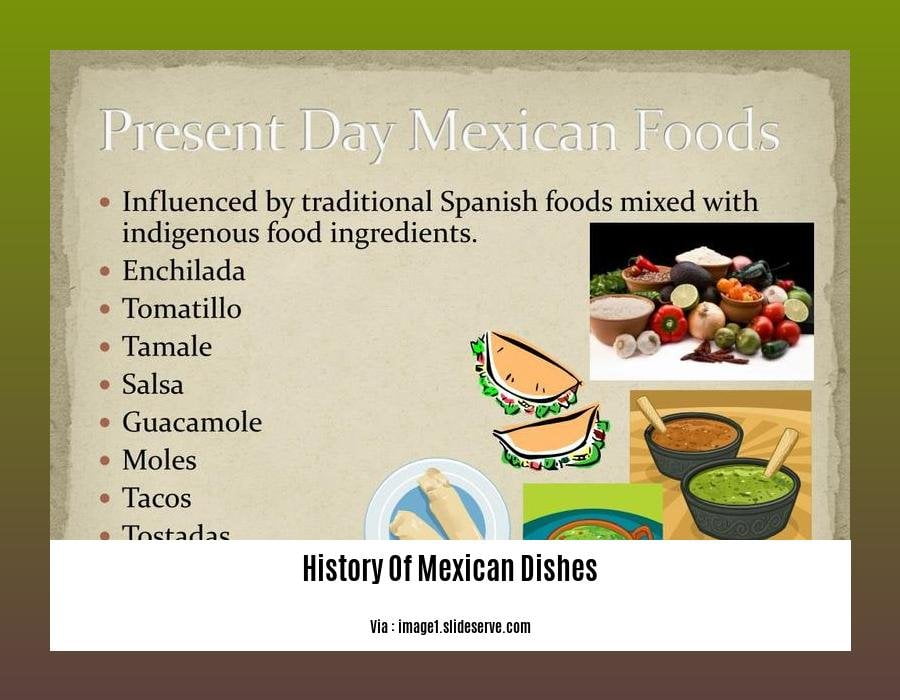
Unlocking the Flavors of Tradition
Mexican cuisine, a vibrant tapestry of flavors and aromas, draws upon a rich history that spans centuries. Embark on a culinary adventure as we delve into the captivating stories behind some of Mexico’s most iconic dishes, tracing their origins and exploring the cultural influences that have shaped their unique character.
Tacos: A Culinary Canvas
Picture a warm, freshly made tortilla, embracing a symphony of fillings that range from savory meats to tangy salsas. Tacos, a quintessential Mexican street food, have captivated taste buds across the globe with their versatility and endless variations.
Their humble beginnings can be traced back to the pre-Hispanic era, where indigenous communities used tortillas to wrap various fillings. Over time, tacos evolved and were influenced by Spanish culinary techniques, resulting in the diverse array of fillings and styles we know today.
Enchiladas: A Symphony of Flavors
Enchiladas, a beloved dish characterized by its delectable combination of corn tortillas, savory fillings, and rich sauces, holds a special place in Mexican gastronomy.
The origins of enchiladas can be traced back to the ancient Aztecs, who soaked tortillas in chili sauces to create a flavorful dish. This culinary tradition continued to evolve, with Spanish influences introducing new ingredients like cheese and spices.
Today, enchiladas are a staple of Mexican cuisine, with regional variations such as enchiladas verdes (green sauce) and enchiladas potosinas (stuffed with potatoes) showcasing the diversity of this dish.
Mole Poblano: A Culinary Masterpiece
Mole poblano, a complex and flavorful sauce originating from the city of Puebla, is considered one of the most iconic dishes in Mexican cuisine. Its rich, deep flavor profile is achieved through a laborious process that involves blending over 20 ingredients, including chilies, spices, nuts, seeds, and chocolate.
The origins of mole poblano are shrouded in mystery, with various legends and tales attempting to explain its creation. One popular story attributes its invention to a group of nuns in a Puebla convent who accidentally combined various ingredients while preparing a feast.
Regardless of its origins, mole poblano has become a symbol of Mexican culinary artistry and is often served on special occasions such as weddings and religious festivals.
As we savor the flavors of these iconic Mexican dishes, let us remember that they are more than just culinary creations—they are a testament to Mexico’s rich cultural heritage, a tapestry woven with the threads of history and tradition.
Do you want to go on an exciting journey through the history of Mexican cuisine? Look no further! Embark on a delectable voyage into Mexico’s rich culinary heritage by exploring the fusion of flavors that have shaped its unique and beloved cuisine. history of mexican cuisine
Have you ever wondered how the vibrant flavors and diverse ingredients of Mexican food came to be? Delve into the fascinating history of Mexican food and discover the culinary influences that have shaped its unique character over the centuries. From ancient Mesoamerican civilizations to the arrival of European colonizers, explore the evolution of dishes that have become iconic symbols of Mexican cuisine worldwide. history of mexican food
Mole Poblano: The Enduring Legacy of a Complex Masterpiece
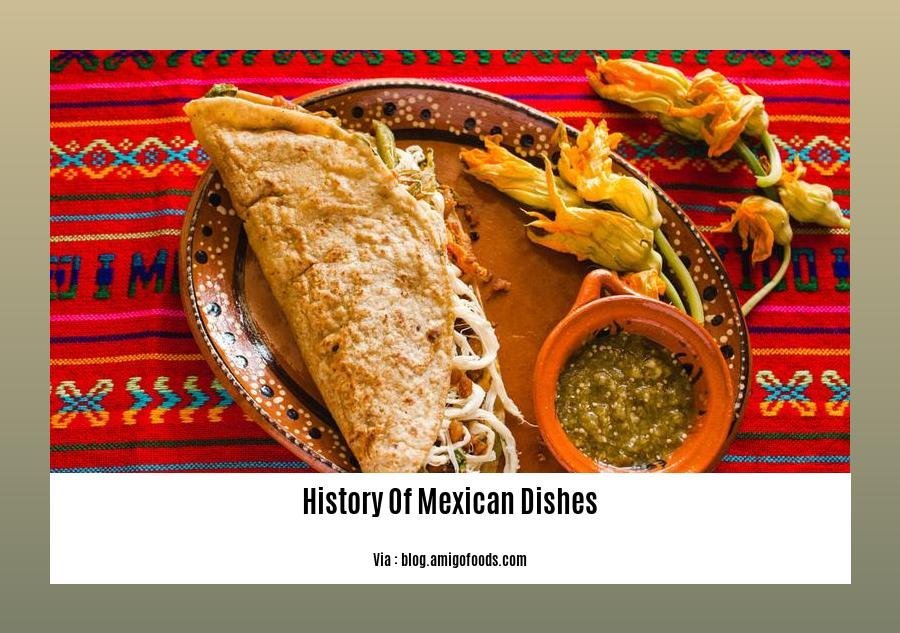
Imagine a dish so rich and complex that it’s been captivating palates for over 300 years. Meet mole poblano, Mexico’s national dish, a culinary masterpiece that’s more than just a meal—it’s a journey through history and culture.
A Symphony of Flavors
Mole poblano is a symphony of flavors, a harmonious blend of over 20 ingredients, including chilies, spices, nuts, seeds, and the unlikely star, chocolate. This unique combination creates a sauce that’s both rich and complex, with a hint of sweetness that dances on the tongue.
A Culinary Fusion
The origins of mole poblano are as diverse as its ingredients. It’s believed to have been born in the kitchens of Puebla, a city in central Mexico, and is thought to be a fusion of indigenous and Spanish culinary traditions. The result is a dish that’s uniquely Mexican, a testament to the country’s rich cultural heritage.
A Labor of Love
Making mole poblano is a labor of love, often taking days to prepare. It’s a time-honored tradition that’s often passed down through generations. Each family has its own secret recipe, with variations in the ingredients and techniques used.
A Culinary Celebration
Mole poblano is more than just a dish; it’s an expression of Mexican identity and culture. It’s often served on special occasions, such as weddings, festivals, and the country’s Independence Day, known as Cinco de Mayo.
Key Takeaways:
Mole poblano is a traditional Mexican dish that has remained unchanged for over 300 years.
It is made from a unique mixture of chocolate and hot peppers, providing a rich and complex flavor.
The dish has deep cultural and religious significance in Mexico, with the process of making it being time-consuming and labor-intensive.
Mole poblano is considered the national dish of Mexico and is often served on special occasions such as Cinco de Mayo.
Sources:
Mole Poblano: A History of This Authentic Mexican Dish
[A Brief History Of Mole, Mexico’s National Dish] (https://theculturetrip.com/north-america/mexico/articles/a-brief-history-of-mole-mexicos-national-dish/)
The Role of Corn in Shaping Mexican Cuisine
Mexican cuisine would be incomplete without corn, as it holds a fundamental place in the nation’s culinary narrative. For over seven millennia, this versatile grain has been revered as a sacred crop, deeply intertwined with Mexican culture.
Corn’s journey in Mexico began with its domestication by indigenous communities. Over time, they developed meticulous techniques for cultivating and preparing corn, transforming it into an array of delectable dishes.
Tortillas, the cornerstone of Mexican cuisine, are crafted from corn masa, creating the ideal canvas for tacos, enchiladas, and burritos. Tamales, another corn-based delicacy, are steamed parcels of masa filled with savory ingredients, offering a delightful blend of textures and flavors.
The versatility of corn extends to beverages as well, most notably in the form of pozole, a hearty soup made with hominy, and the refreshing agua fresca, prepared with fresh corn and water.
Key Takeaways:
Corn’s history in Mexico dates back over 7,000 years, holding deep cultural and culinary significance.
Corn masa forms the foundation of tortillas, a staple ingredient in many Mexican dishes, including tacos and enchiladas.
Tamales, steamed parcels of corn masa, offer a delightful combination of textures and flavors, often filled with savory ingredients.
Mexican cuisine showcases corn’s versatility, extending to beverages such as pozole, a hominy-based soup, and agua fresca, prepared with fresh corn and water.
Sources:
The Importance of Corn in Mexican Culture and Cuisine
Corn in Mexican Cuisine: A Staple Ingredient with a Rich History
Mexican Street Food: A Symphony of Flavors and Cultural Exchange
In the heart of bustling Mexican cities, a symphony of flavors unfolds within the vibrant tapestry of street food, a culinary tradition rooted in the ancient Aztec civilization. From the humble taco to the tantalizing enchilada and the rich mole poblano, these dishes are not mere sustenance; they are cultural treasures that embody the heritage, diversity, and resilience of Mexico.
Tacos: A Culinary Tapestry of Flavors
Tacos, the quintessential Mexican street delicacy, are a testament to the country’s rich culinary history. Originating from pre-Hispanic communities, these versatile maize tortillas have evolved with time, embracing Spanish influences and transforming into a canvas for a myriad of delectable fillings. Today, tacos are an emblem of Mexican cuisine, satiating taste buds with their endless variations, from the classic al pastor to the modern cochinita pibil.
Enchiladas: A Symphony of Corn, Sauces, and Flavors
Enchiladas, another Mexican culinary masterpiece, showcase the country’s mastery of maize and sauces. These corn tortillas, adorned with savory fillings such as cheese, beans, or meat, are bathed in a rich, aromatic sauce, creating a symphony of flavors that dances on the palate. From the vibrant red enchiladas rojas to the creamy green enchiladas verdes, each bite is a journey into the diverse culinary traditions of Mexico.
Mole Poblano: A Culinary Masterpiece from Puebla
Among Mexico’s culinary treasures, mole poblano stands out as a masterpiece of gastronomy. This complex sauce, originating from the city of Puebla, is a testament to Mexico’s rich cultural heritage and culinary ingenuity. Prepared with a symphony of over 20 ingredients, including chilies, spices, nuts, seeds, and chocolate, mole poblano is a labor of love that rewards the patient cook with a rich, complex, and unforgettable flavor.
A Symphony of Flavors: The Cultural Significance of Mexican Street Food
Mexican street food is more than just a culinary delight; it is a reflection of the country’s vibrant culture and history. Embracing influences from indigenous, Spanish, and modern traditions, these dishes represent the resilience and creativity of the Mexican people.
- The use of maize, a sacred crop for Mesoamerican civilizations, symbolizes the deep connection between Mexican cuisine and its ancient roots.
- The vibrant colors, bold flavors, and diverse aromas of street food reflect the joyous and celebratory spirit of Mexican culture.
- The communal aspect of sharing street food fosters a sense of togetherness and community, reinforcing the social fabric of Mexican society.
Key Takeaways:
- Mexican street food, known as antojitos, originated in ancient Aztec markets and reflects the country’s culinary heritage.
- Tacos, enchiladas, and mole poblano are iconic dishes that showcase the diversity of Mexican cuisine.
- Tacos, with their myriad fillings, represent the adaptability and creativity of Mexican cuisine.
- Enchiladas, with their rich sauces, embody Mexico’s mastery of maize and sauces.
- Mole poblano, with its complex ingredients, is a culinary masterpiece from the city of Puebla.
- Mexican street food is not just about flavors; it represents Mexico’s cultural identity and fosters a sense of community.
Sources:
- Street Food in Mexico: A Culinary Journey
- The History of Mexican Street Food
FAQ
Q1: What are the origins of Mexican cuisine?
A1: Mexican cuisine is a blend of indigenous and Spanish traditions, with influences from other countries. The Mayans and Aztecs were the earliest civilizations in Mexico, and their cuisine was based on corn, beans, and squash. The Spanish brought new ingredients like wheat, rice, dairy, and meat, which were incorporated into Mexican cooking.
Q2: What is the most popular Mexican dish?
A2: Tacos are the most popular Mexican dish. They are made with a corn or flour tortilla filled with meat, fish, or vegetables. Tacos can be served with a variety of toppings, such as salsa, cheese, and sour cream.
Q3: What is the national dish of Mexico?
A3: Mole poblano is the national dish of Mexico. It is a complex sauce made with a variety of ingredients, including chocolate, chilies, and spices. Mole poblano is typically served with chicken or turkey.
Q4: What is the history of corn in Mexican cuisine?
A4: Corn is native to Mexico and has been cultivated there for at least 7,000 years. It is a staple food in Mexican cuisine and is used to make a variety of dishes, including tortillas, tamales, pozole, and elote. Corn is also used to make a variety of alcoholic beverages, such as tequila and mezcal.
Q5: What are some popular antojitos?
A5: Antojitos are a type of Mexican street food that is typically made with masa, a type of cornmeal. Some popular antojitos include tacos, enchiladas, tamales, pozole, and tlacoyos. Antojitos are often served with a variety of salsas, cheeses, and other toppings.
